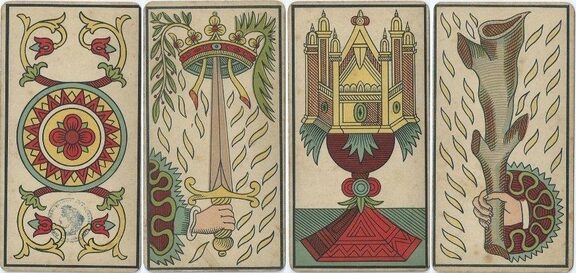Some Thoughts on The Tarot and Neo-Paganism
Divination is a valuable spiritual practice for Pagans for many reasons. If you believe in an immanent Divinity that is present in everything, being able to find wisdom in something as mundane as a pack of cards is a good reminder that the Gods are everywhere! It teaches us to seek out meaning, and that imbues our lives with sacredness. It can also teach us to understand symbols and archetypes, and that knowledge will deepen our ritual practices. It can show us all the parts of our selves, from many different angles, si we can connect more with our authentic, Divine selves, and to see our Shadows and then transform them.
I have heard many Pagans complain about Tarot decks with feature a lot of Christian imagery, but I think it's important to understand where the Tarot comes from, and why it's there. There are a lot of decks with specifically Pagan themes, some of which are lovely.. but to me, the traditional Tarot is really a melting pot of symbolism from a lot of different sources, and it transcends any religious divisions.
The oldest known packs of Tarot come to us from the 1400s in Italy, and at that time, Catholic iconography was everywhere. The archetypes of the major arcana can be found all over the place in the popular culture of the time. Cards like the Pope (later renamed the Hierophant), Judgement, and the Devil clearly show Christian concepts, and the Cardinal Virutes were also present, but we can see some heretical ideas in there, too-- like the Papess (the female pope, later called the High Priestess). Also there are alchemical and astrological symbols like the Sun, the Moon, the Star, and Temperence. The minor arcana are older than the majors, and are based on playing cards from the Middle East. Some people think that they contain Sufi symbolism in their structure. Later, A.E. Waite created the Rider Tarot, and was largely inspired by the mythology of the Holy Grail, which features elements of both Christian and Pagan ideology.
In modern Tarot, there are many decks which aim themselves towards a specific market, recreating the symbols in a new form to appeal to a particular audience. Pagan-oriented decks are popular, and there are a lot of them. Some are classics, which have been around for decades, like Ellen Cannon Reed's “Tarot of the Witches” which uses both Wiccan and Qabalistic symbols (though some might find the art a little dated), or Liz Greene and Tricia Newell's “Mythic Tarot", which is populated with figures from Greek Mythology, and accompanied by a book connecting the cards to Jungian ideas, or the “Robin Wood Tarot”, which is based on the Rider Waite, but with more Pagan imagery. In the last few years, a huge number of Pagan decks have come out. The Druidcraft is inspired by both Wicca and Druidism, and has beautiful art. The newly released “Gaian Tarot” features realistic-looking imagery and focuses on earth-based spirituality. Keep an eye out for the new “Wildwood Tarot”, which is a re-working of the long out-of-print “Greenwood Tarot”, which featured themes about pre-Celtic European Shamanism.
Sometimes, using these kind of decks can be helpful, if it assists us to feel a more personal connection to a symbol... but be you may want to give a thought to thematic decks which repackage an archetype to make it more palatable, and end up losing the meaning of the card in the process.
Sometimes we might have a tendency to avoid a symbol that causes a reaction in us-- but if it bothers you, that's a good sign that it is a powerful symbol for you, and there's something in your subconscious that may find value in working with it and confronting it.
When we have cards like the Devil and the Pope in the deck, we could see universal human themes in them, beyond the Christian themes. Things like the outer structures of spiritual practice can be shown in the Pope card, or ideas of spiritual discipline. The Devil can show the restrictive nature of our fears, or it might talk about our more primal urges. If we change these cards instead to 'the Shaman', and 'The Horned God', do they still carry the same connotations? Just some food for thought.
If we want to work with more Pagan-centric Divination forms, we might try something other than Tarot. Ogham staves are a Celtic divination form based on tree symbolism, and the Runes are a Norse Pagan magickal alphabet. Or we might try casting stones or bones, or better yet, just go out into Nature and practice listening to what's in front of us. We need to pay careful attention to our own inner voice, the voice of the Divine, and the voice of the world-- when we can first hear those with clarity, we will be much better at reading the cards.
